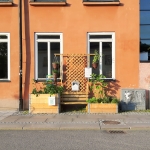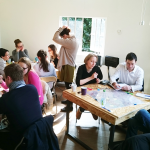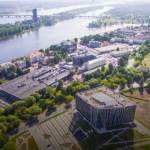In the spring 2016, the ”new dynamics of services” was chosen as the pilot focus area by the pilot team because it was seen possible to develop the campus services bottom-up and with limited resources.
Thus in May, we organised a stand tour in four different locations on the higher education campus of Turku to find out, how to develop campus services user centered. The locations were chosen so that there was one stand in every sub-region that we had defined earlier in the pilot.
We put the stands next to lunch restaurants during the peak hours to reach as many people as possible. People were asked to write feedback on sticky notes and locate the notes on a campus map into right location. On blue notes they added services and activities that already functioned, and on orange notes services or activities that were missing or working poorly.
During just 2–3 hours, we received almost 100 or even more feedback notes per one stand. People also discussed with us gladly, and some stayed even for a longer talk. There were 1–3 facilitators guiding on the stands at the time.
Outcomes
Out of the 500 notes in total, 369 notes were for improvement needs, and 131 for positive feedback. We sorted the notes further by sub-regions, and applied the division of campus services by Alexandra den Heijer. One note could fall in several categories.
Academic incl. classes, lecture halls, libraries, working, study and club rooms, laboratories, campus sport and health care, communication, lockers, etc.
Accommodation incl. student residents, hotels, temporary accommodation, housing, etc.
Business related incl. start-ups, incubators, business, etc.
Retail and leisure incl. other sport than campus sport, restaurants, cafes, commercial services, etc.
Infrastructure incl. IT, trafficking, outdoor areas, toilets, guiding, indoor air quality,
guarding, parking, lightning, passage and key systems, etc.
The amount of representations in the categories Retail and Leisure (218) and Infrastructure (235)
were clearly dominant and almost equal also among the sub-regions. The share of Academic services (86) was app. one sixth of all representations. The lack of Residential (6) and Business related (3) representations in general was surprising.
Few examples
Student space development was on the top wish list in all the sub-regions. Participants wished for example:
– informal places for students to stay and relax, sofas etc., e.g. older lecture and IT rooms
could be transformed into student spaces, the river bank could be used more in
summertime for students
– places to read and study in silence, also in the evenings and with an access to toilet
– places for groups and working, also incl. IT and with more easy access
– places to organize events and other activities
– places for student unions and clubs to meet and organize events
– places, where all the higher education students in Turku can meet and work together.
They also wished in general for a better access and information about room for students, and more suitable price level for students to organise events.
Conclusions
Based to the results from the stands, the most prominent themes to continue the service development on the Turku higher education campus dealt with quite basic services and activities:
– development of more and more diverse study, work, hangout, and club and community spaces for students
– development of light traffic and routes, and especially biking; development of parking
places
– development of restaurants and cafes and serving also after 2–3 p.m.
The feedback from students, staff and visitors helped us to proceed and focus our pilot further a great deal. It was also educational to test and apply a self modified participatory method in action. Happily it seemed to work pretty nicely and gave the big picture of the present services and activities on the higher education campus. The final results were also shared with the key stakeholders.
By Johanna Aaltonen & Tiina Anttila, University of Turku, Turku pilot of Live Baltic Campus









